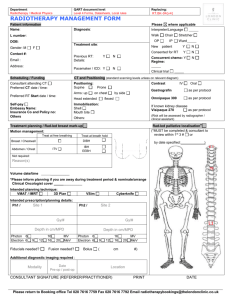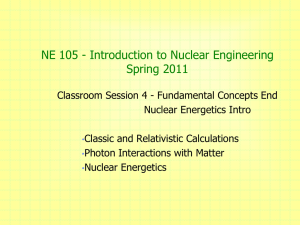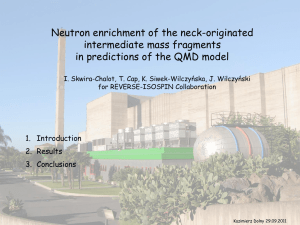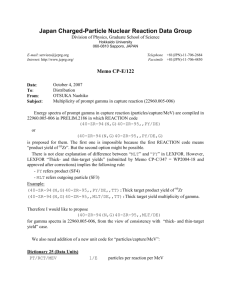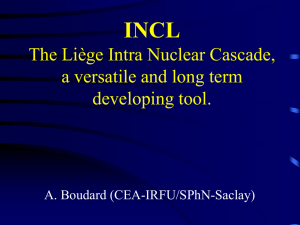Structura - cadru pentru formularele de propuneri de proiecte
advertisement
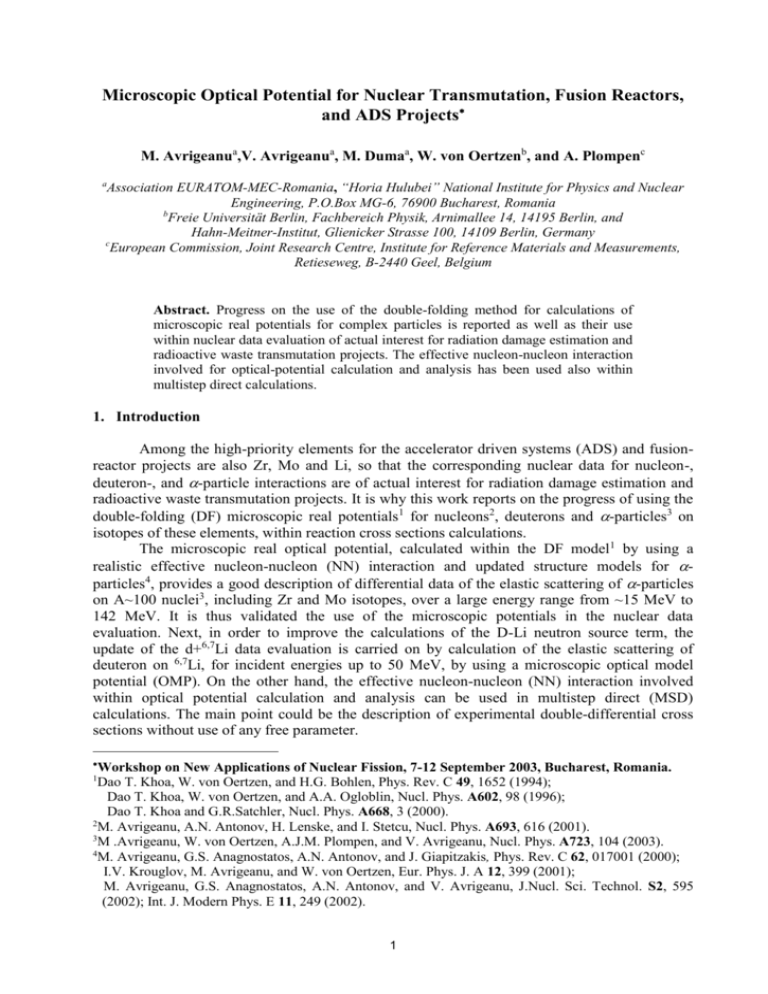
Microscopic Optical Potential for Nuclear Transmutation, Fusion Reactors, and ADS Projects M. Avrigeanua,V. Avrigeanua, M. Dumaa, W. von Oertzenb, and A. Plompenc Association EURATOM-MEC-Romania, “Horia Hulubei” National Institute for Physics and Nuclear Engineering, P.O.Box MG-6, 76900 Bucharest, Romania b Freie Universität Berlin, Fachbereich Physik, Arnimallee 14, 14195 Berlin, and Hahn-Meitner-Institut, Glienicker Strasse 100, 14109 Berlin, Germany c European Commission, Joint Research Centre, Institute for Reference Materials and Measurements, Retieseweg, B-2440 Geel, Belgium a Abstract. Progress on the use of the double-folding method for calculations of microscopic real potentials for complex particles is reported as well as their use within nuclear data evaluation of actual interest for radiation damage estimation and radioactive waste transmutation projects. The effective nucleon-nucleon interaction involved for optical-potential calculation and analysis has been used also within multistep direct calculations. 1. Introduction Among the high-priority elements for the accelerator driven systems (ADS) and fusionreactor projects are also Zr, Mo and Li, so that the corresponding nuclear data for nucleon-, deuteron-, and -particle interactions are of actual interest for radiation damage estimation and radioactive waste transmutation projects. It is why this work reports on the progress of using the double-folding (DF) microscopic real potentials1 for nucleons2, deuterons and -particles3 on isotopes of these elements, within reaction cross sections calculations. The microscopic real optical potential, calculated within the DF model1 by using a realistic effective nucleon-nucleon (NN) interaction and updated structure models for particles4, provides a good description of differential data of the elastic scattering of -particles on A~100 nuclei3, including Zr and Mo isotopes, over a large energy range from ~15 MeV to 142 MeV. It is thus validated the use of the microscopic potentials in the nuclear data evaluation. Next, in order to improve the calculations of the D-Li neutron source term, the update of the d+6,7Li data evaluation is carried on by calculation of the elastic scattering of deuteron on 6,7Li, for incident energies up to 50 MeV, by using a microscopic optical model potential (OMP). On the other hand, the effective nucleon-nucleon (NN) interaction involved within optical potential calculation and analysis can be used in multistep direct (MSD) calculations. The main point could be the description of experimental double-differential cross sections without use of any free parameter. Workshop on New Applications of Nuclear Fission, 7-12 September 2003, Bucharest, Romania. Dao T. Khoa, W. von Oertzen, and H.G. Bohlen, Phys. Rev. C 49, 1652 (1994); Dao T. Khoa, W. von Oertzen, and A.A. Ogloblin, Nucl. Phys. A602, 98 (1996); Dao T. Khoa and G.R.Satchler, Nucl. Phys. A668, 3 (2000). 2 M. Avrigeanu, A.N. Antonov, H. Lenske, and I. Stetcu, Nucl. Phys. A693, 616 (2001). 3 M .Avrigeanu, W. von Oertzen, A.J.M. Plompen, and V. Avrigeanu, Nucl. Phys. A723, 104 (2003). 4 M. Avrigeanu, G.S. Anagnostatos, A.N. Antonov, and J. Giapitzakis, Phys. Rev. C 62, 017001 (2000); I.V. Krouglov, M. Avrigeanu, and W. von Oertzen, Eur. Phys. J. A 12, 399 (2001); M. Avrigeanu, G.S. Anagnostatos, A.N. Antonov, and V. Avrigeanu, J.Nucl. Sci. Technol. S2, 595 (2002); Int. J. Modern Phys. E 11, 249 (2002). 1 1 2. Double-folding method calculation of nuclear potential for complex particles. Since the IFMIF project requests nuclear-data evaluation for D incident on 6,7Li for Denergies up to 50 MeV, we have analyzed and proved2,4 the possibility of using the DF method for calculation of the nuclear potential for complex particles (e.g. 2,3H, 3,4He) emitted in neutron induced reactions on medium nuclei, as well as of interest5 for evaluation of nuclear data for D on 6,7Li. The basic input for the calculations of the double-folded OP are the nuclear densities of the colliding nuclei and the effective nucleon-nucleon (NN) interaction. Several types of the most recent densities associated to -particle have been used in addition to the most known expression of Satchler and Love6, namely the experimental Tanihata densities7, the realistic densities derived from the cluster-orbital shell model approximation8 (COSMA), and the microscopic Baye density. The energy- and density-dependent (DDM3Y and BDM3Y) effective Paris and Reid NN have been considered with an explicit treatment of the exchange potential9. 3. Microscopic optical potential for -particles interacting with 90Zr The microscopic real OPs have been validated through the comparison with the phenomenological OPs and the description of the systematics of the experimental -particle elastic-scattering angular distributions. It is important to underline that no adjustable parameter or normalization constant are involved within the microscopic calculations. The volume integrals of the real phenomenological10 and of the microscopic potentials for +90Zr based on the Tanihata density and DDM3Y-Paris effective interaction have been found in the best agreement. Calculated differential elastic scattering cross sections of +90Zr at incident energies of 40, 59.1, 79.5, 99.5, 118, and 141.7 MeV using the DDM3Y-Paris effective NN interactions with both Tanihata and COSMA densities are presented in comparison with the experimental data. It has been thus shown that the present microscopic potential is able to describe the experimental angular distributions of elastic scattered -particle over a large incident energy range. Moreover, a comparative analysis shows that the microscopic elastic-scattering and total reaction cross-sections are in good agreement with those predicted by the phenomenological optical potentials along the whole energy range analyzed. This final comparison validates the procedure of calculating microscopic optical potential and its use in applications. 4. Calculation of Deuterium-Lithium cross sections for energies up to 50 MeV Nuclear density distributions. The deuteron density distribution has been obtained following the analysis of both the deuteron ground state wave functions given by either Satchler 11, Lacombe et al.12 or Machleidt13, and the experimental charge density14. We have considered only the S-state 5 A.Yu. Konobeyev, Yu.A. Korovin, P.E. Pereslavtsev, U. Fisher, and U. von Mollendorff, Nucl. Sci. Eng. 139, 1 (2001). 6 G.R. Satchler and W.G. Love, Phys. Rep. 55, 183 (1979). 7 I. Tanihata et al., Phys. Lett. B 289, 261 (1992). 8 M.V. Zhukov et al., Phys. Rep. 231, 151 (1993). 9 Dao T. Khoa, Phys. Rev. C 63, 034007 (2001). 10 L.W. Put and A.M.J. Paans, Nucl. Phys. A291, 93 (1977); L.McFadden and G.R. Satchler, Nucl. Phys. A84, 177 (1966); M. Nolte, H. Machner, and J. Bojowald, Phys. Rev. C 36, 1312 (1987); V. Avrigeanu, P.E. Hodgson, and M. Avrigeanu, Phys. Rev. C 49, 2136 (1994). 11 G.R. Satchler, Phys. Lett. B 36, 169 (1971). 12 M. Lacombe et al., Phys. Lett. B 101, 139 (1981). 13 R. Machleidt, Adv. Nucl. Phys. 19, 189 (1989). 14 D. Abbot et al., Eur. Phys. J. A 7, 421 (2000). 2 of the deuteron ground state wave function, so that the effective NN-interaction used in the double folding procedure has no tensor component Therefore in the present work we have used the Machleidt wave function for calculations of the deuteron density distribution. The nuclear density distribution of the target nuclei 6,7Li has been described by means of a gaussian forms with the parameters obtained from the analysis of the electron scattering data 15,16 and also from the shell model calculations17. Finally the Bray et al.16 density distribution for 6Li target and Satchler and Love6 density distribution for 7Li target have been chosen. The effective NN interaction. Several versions like the M3Y and different types of its density dependence like DDM3Y, BDM3Y, and CDM3Y effective interactions18 were developed and used to fit nucleon- and nucleus-nucleus elastic-scattering angular distributions. The most popular M3Y forms are based on the G-matrix elements of the Reid19 or Paris20 NN potential in an oscillator basis. Since the M3Y effective interaction is characteristic for the nuclear density around 1/3 of the normal matter density, its choice could be considered appropriate for the deuteron scattering which is localized in the nuclear surface 21 at lower incident energies (3-15 MeV). In this work we have chosen the Paris M3Y effective interaction for the complete consistency with the density distribution of the deuteron whose ground-state wave function has been obtained from Paris effective interaction. For higher incident energies of the deuterons incident on 6Li, e.g. above 25 MeV, the density dependence of the effective NNinteraction has been also taken into account. It has been modeled by looking for the proper account of the saturation properties of nuclear matter1 within a corresponding Hartree-Fock calculation, and accounts for the reduction in the strength of the interaction that occurs as the density of the surrounding medium increases. The density-dependent DDM3Y and BDM3Y effective NN interactions have been obtained by multiplying with the density-dependent function F() adjusted by reproducing the saturation point of the nuclear matter and a compressibility modulus of K~230 MeV. Moreover, in addition to the density dependence it was also introduced an energydependent factor as a linear function of the incident energy per nucleon E, of the form g(E)=1/E. The coefficient has the values 0.002 and 0.003 for the M3Y-Reid1,18 and M3Y-Paris19 interactions, respectively. Finally, for 50 MeV deuterons incident on 6Li target we built the semi-microscopic DFM real potential based on the Machleidt S wave function of deuteron, Bray et al. density distribution for 6Li and the above-given BDM3Y Paris effective NN-interaction. Elastic scattering angular distributions. The real DF potential calculated with the ingredients described above has been applied for description of the deuteron scattering data at low energies, in conjunction with Woods-Saxon imaginary and spin-orbit potentials. The present calculations have been compared with the deuteron-6,7Li elastic-scattering angular distributions22,23 measured at incident energies between 3 and 50 MeV for the target nucleus 6Li (Fig. 1), and between 3 and 14.7 MeV for the target nucleus 7Li (Fig. 2). 15 G.C. Li, I. Sick, R.R. Whitney, and M.R. Yearian, Nucl. Phys. A162, 583 (1971); T. Sinha, Subinit Roy, and C. Samanta, Phys. Rev. C 48, 785 (1993). 16 K.H. Bray, et al., Nucl. Phys. A 189 (1972) 35. 17 A.A. Korsheninnikov et al., Nucl. Phys. A617, 45 (1997); M. El-Azab Farid and M.A. Hassanain, Nucl. Phys. A 697, 183 (2002). 18 M.E. Brandan and G.R. Satchler, Phys. Rep. 285, 143 (1997); Dao T. Khoa, Phys. Rev. C 63, 034007 (2001). 19 G. Bertsch, J. Borysowicz, H. McManus, and W.G. Love, Nucl. Phys. A284, 399 (1977). 20 N. Anantaraman, H. Toki, and G. Bertsch, Nucl. Phys. A398, 279 (1983). 21 M. Avrigeanu, A. Harangozo, V. Avrigeanu, A.N.Antonov, Phys.Rev.C 54,2538(1996); 56,1633(1997). 22 S.N. Abramovich et al., Yad. Phys. 40, 842 (1976), and EXFOR-A0117 data-file entry; D.L. Powell et al., Nucl. Phys. A147, 65 (1970), and EXFOR-A1432 data-file entry; H.G. Bingham et al., Nucl. Phys. A173, 265 (1971), and EXFOR-A1431 data-file entry; H. Ludecke et al., Phys. A109, 676 (1968), and 3 3 6 6 5 MeV Abramovich + (1976) el. sc. calc. 3 MeV Abramovich + (1976) Powell + (1965) el. sc. calc. Abramovici + (1976) el. sc. calc. 2 10 d/d [mb/sr] 4 MeV Li(d,d0) Li 10 1 10 30 60 90 120 150 30 60 90 120 150 6 MeV 3 10 30 60 90 120 150 180 8 MeV 7 MeV Abramovich + (1976) Bingham + (1971) el. sc. calc. Abramovich + (1976) el. sc. calc. Abramovich + (1976) el. sc. calc. 2 10 1 10 30 60 90 120 150 30 60 90 120 150 9 MeV 10 MeV 3 10 12 MeV Bingham + (1971) el. sc. calc. Abramovich + (1976) Bingham + (1971) el. sc. calc. Abramovich (1976) el. sc. calc. 2 30 60 90 120 150 180 10 1 10 30 60 90 120 150 180 30 60 90 120 150 180 30 4 10 3 10 2 10 60 90 120 150 180 2 14.7 MeV 19.6 MeV Matsuki + (1969) CRC elastic -transfer Chuev + (1971) CRC elastic -transfer 1 10 50 MeV 1 10 Rudchik + (1996) el. sc. calc. 0 10 -1 0 10 10 0 30 60 90 120 150 10 30 60 90 120 150 180 0 30 60 90 120 150 180 c.m. [deg] Fig. 1. Comparison of measured and calculated deuteron-6Li elastic-scattering angular distributions at incident energies between 3 and 50 MeV. EXFOR-F0002 data-file entry; S. Matsuki et al., Jap. Phys. J. 26, 1344 (1969), and EXFOR-A1435 data-file entry; V.I. Chuev et al., J. de Phys. 32 (1971) C6. 23 A.T. Rudchik, A. Budzanoki et al. Nucl. Phys. A602, 211 (1996). 4 7 3 7 5 MeV 4 MeV Li(d,d0) Li 10 Abramovich + (1976) Abramovich + (1976) 3 MeV 2 10 d/d [mb/sr] 1 Abramovich+(1976) 10 3 10 30 60 90 120 150 30 60 90 120 150 6 MeV 7 MeV Abramovich + (1976) 30 60 90 120 150 180 8 MeV Abramovich + (1976) Abramovich + (1976) 2 10 1 30 60 90 120 150 10 MeV 9 MeV 3 10 Abramovich+ (1976) Abramovich + (1976) 2 10 2 10 11.8 MeV 1 10 1 10 30 60 90 120 150 d/d [mb/sr] 30 60 90 120 150 180 d/dRutherford 10 30 60 90 120 150 3 10 30 60 90 120 150 180 12 MeV Ludecke + (1968) 0 10 30 60 90 120 150 180 14.7 MeV Matsuki + (1969) Bingham + (1971) 2 10 1 10 30 60 90 120 150 30 60 90 120 150 180 c.m. [deg] Fig. 2. As for Fig. 1 but for the target nucleus 7Li and incident energies between 3 and 14.7 MeV. The scattering cross sections are calculated by using the code24 SCAT2 modified to include the DF potential as OMP real-part option, with no adjustable parameter or normalization constant. 24 O. Bersillon, Centre d'Etudes de Bruyeres-le-Chatel Note CEA-N-2227, 1992. 5 CRC analysis for the deuteron exchange. The general feature of experimental d+6,7Li elastic-scattering angular distributions at low incident energies is an increase in the yield at large angles. The scattering in the backward direction determines the optical model parameters to be used for the description of the elastic scattering data. Nevertheless, adjusting the parameters or the type of the optical model to the case under consideration does not always help to provide a satisfactory correspondence to the pronounced maxima at very large angles. In attempts to interpret the data in such cases the direct exchange processes has been employed 25. Reactions of interest in which exchange effects are supposed to be of significance are the elastic scattering of both deuterons and alpha particles by 6Li, nucleus which has the simplest alpha cluster structure, i.e. an alpha particle loosely bound to a deuteron or a p-n pair26. In the case of deuteron elastic scattering on 6Li at energies of 14.7 and 19.6 MeV (Fig. 1) search for the imaginary and spin-orbit OMP parameters led to a good description of the forward angles, while at larger angles the disagreement has been obvious. It seems that not merely accidental since it is in line with the experimental angular distributions obtained by Bingham et al.27 and Abramovich et al.28. The results are improved by taking into account also the coupled reaction channel (CRC) model predictions of the code FRESCO29. Thus the maximum of the angular distribution at extremely backward angles is reproduced fairly well by the CRC. The coupling routes taken into account in the present analysis involve both -particle and the sequential deuteron exchange in the 6Li nucleus, by using Timofeyuk and Thompson30 spectroscopic factor for the -particle in 6Li and Rudchik et al.23 spectroscopic factor of the deuteron in the -particle. It appears25 that the exchange-effects probability has to decrease strongly with increasing energy of the incident particle, e.g. for the deuteron increased energy the characteristic momentum with which it captures the -particle to form the ground state of 6Li must increase as well. At the same time the binding energy of the cluster 6Li=+d is only 1.47 MeV, the relative effective momentum between its constituents not being large. Thus, the experimental elastic angular distribution23 of 50 MeV deuterons on 6Li has been described only by pure elastic scattering calculations, as long as the experimental data are measured only up to 155 degrees. 5. Quantum-statistical MSD processes at low and intermediate energies on 90Zr and 100Mo The quantum mechanical formalism developed by Feshbach, Kerman and Koonin31 (FKK) for the multistep processes has been extensively used to describe a large amount of experimental data covering a broad energy range. The assumptions and simplifying approximations considered in the application of the FKK theory have been analyzed and important refinements of calculations have been made (e.g.32 and references therein). One of the important assumptions concerns the effective NN interaction, which is taken as a single Yukawa term with 1 fm range, its strength V0 being considered as the only free parameter of the FKK theory. However, it should be noted that, even when a consistent standard parameter set has been used as well as several other effects have been taken into account, the systematics of the phenomenological V0 values still show discrepancies. Such uncertainties of the 25 V.Z. Goldberg, K.A. Gridnev, E.F. Hefter, and B.G. Novatskii, Phys. Lett. B 58, 405 (1975). T. Yoshimura et al., Nucl. Phys. A641, 3 (1998). 27 H.G. Bingham et al., Nucl. Phys. A173, 265 (1971), and EXFOR A1431 data-file entry. 28 S.N. Abramovich et al., Yad. Phys. 40, 842 (1976), and EXFOR A0117 data-file entry. 29 I.J. Thompson, Comput. Phys. Reports 7, 167 (1988). 30 N.K. Timofeyuk and I.J. Thompson, Phys. Rev. C 61, 044608 (2000). 31 H. Feshbach, A. Kerman, and S. Koonin, Ann. Phys. (NY) 125, 429 (1980). 32 M.B. Chadwick et al., Acta Phys. Slovaca 49, 365 (1999). 26 6 d/dE [mb/MeV] phenomenological effective NN-interaction strengths may reflect the eventual scaling of V0 compensating for some effects which have been neglected and should be added to the theory. Thus, the use a more realistic effective NN interaction, which should be consistent with the corresponding OP real part of the OM, has been stated as one of the open problems in the theoretical description of the MSD nuclear reactions. Through the trial to provide a reliable strength to be used within the FKK theory instead of the free parameter V0, we expect to overcome the uncertainties in fitting an effective interaction directly to MSD processes data. Thus an 1Y-equivalent NN interaction strength V0eq obtained from the DDM3Y-Paris effective interaction has been used within MSD calculations which (a) describes without any free parameter the experimental double-differential cross sections, the nucleon emission spectra from the (p,n) and (p,p') reactions on 90Zr (Fig. 3) and 100Mo (Fig. 4) isotopes at the incident energies of 80 MeV, 100 MeV, and 120 MeV, and (b) makes possible predictions of MSD double-differential cross sections and nucleon emission spectra corresponding to (n,n') and (n,p) reactions on 90Zr and 100Mo isotopes at the incident energies of 80 MeV, 100 MeV, and 120 MeV, where no experimental data exist. 3 10 90 2 10 Zr(p,n) Ep=80 MeV 1 10 Trabandt'89 default (g=A/13; P=0) g=A/13; p-Dilg'73 0 10 -1 10 0 20 40 60 80 En [MeV] 1 10 DDM3Y-Paris En=22 MeV 0 2 d /dEd [mb/MeVsr] 10 -1 10 0 10 En=42 MeV -1 10 -2 10 -1 10 En=62 MeV -3 10 -5 10 30 60 90 120 150 c.m. [deg] Fig. 3. Comparison of experimental and MSD cross sections for the (p,xn) reactions on 90Zr. 7 2 d /dEd [mb/MeV sr] 10 1 10 0 100 10 -1 10 -2 10 -3 ' Mo(p,p ) Einc=120 MeV Ep =80 MeV ' 10 DDM3Y-Paris 0 10 -1 10 -2 Ep =90 MeV ' -3 10 -4 10 10 -1 10 -3 10 -5 Ep =100 MeV Richter et al.'92 default (g=A/13; P=0) P-Dilg'73 20 40 ' 60 80 100 120 140 c.m. [deg] Fig, 4. Comparison of experimental and MSD cross sections for the (p,xn) reactions on 100Mo. The practical FKK calculations become independent by any free parameter, whose phenomenological values may compensate for the questionable handling of other quantities involved in the FKK formalism, e.g. the particle-hole state density, the optical potential for distorted waves, the DWBA matrix elements, the coupling between MSD and MSC emission chains. Therefore further improvements concerning the pairing and shell corrections 33, which are important at low residual excitation energies but for high energetically emitted particles, are foreseen at this stage. These improvements are already included in the semi-classical Geometry Dependent Hybrid (GDH) subroutine of the STAPRE-H code34 (updated version) at IFIN-HH in Bucharest. Acknowledgements. This work was supported at IFIN-HH by the Contract of Association between EURATOM and MEC-Bucharest No. ERB-5005-CT-990101, and by the EC/JRC/IRMM project PA No. 59 during a three-month visit at IRMM-Geel, and the EC/FP5/INCO2 project IDRANAP/WP12 of IFIN-HH during three-month visits at HMI-Berlin. M.A. gratefully acknowledges the warm hospitality at IRMM-Geel and HMI-Berlin. 33 M. Avrigeanu and V. Avrigeanu, J. Phys. G 20, 613 (1994); A. Harangozo, I. Stetcu, M. Avrigeanu, and V. Avrigeanu, Phys. Rev. C 58, 295 (1998). 34 M. Avrigeanu and V. Avrigeanu, STAPRE-H95 Computer Code, IPNE Report NP-86-1995, Bucharest, 1995; News NEA Data Bank 17 (1995) 22, 25. 8

